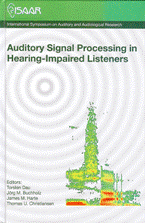Temporal suppression of long-latency click-evoked otoacoustic emissions
Abstract
This paper investigates suppression of click-evoked otoacoustic emissions (CEOAEs) using the same paradigm as Hine and Thornton (2002) in which a suppressor-click was presented close in time to a test-click. The experiment was repeated and the analysis extended to long-latency CEOAEs (duration > 20 ms), whereas the previous study only focussed on the 'short-latency' CEOAE (duration < 20 ms). The hypothesis was that suppression would continue on the long-latency CEOAE since this region is probably dominated by spontaneous OAEs (SOAEs) synchronising with the click stimulus. The results for ve exemplary subjects showed that suppression remained on the long-latency CEOAE, indicating that both SOAEs and CEOAEs originate from the same cochlear nonlinearities, as suggested by Kemp and Chum (1980a). Further proof of suppression of long-latency SOAE components was sought in the spectral domain. A comparison of the magnitude of certain SOAE components in the suppressed and unsuppressed condition for a particular subject showed that suppression affected SOAE components in a similar way as the purely click-evoked OAE components.
References
Hine, J. E. and Thornton, A. R. D. (2002). “Temporal nonlinearity revealed by transient evoked otoacoustic emissions recorded to trains of multiple clicks,” Hear. Res. 165, 128-141.
Kapadia, S., and Lutman, M. E. (2000). “Nonlinear temporal interactions in click-evoked otoacoustic emissions. II. Experimental data,” Hear, Res. 146, 101-120.
Kemp, D. T. (1978). “Stimulated acoustic emissions from within human auditory-system,” J. Acoust. Soc. Am. 64, 1386-1391.
Kemp, D. T., and Chum, R. (1980). “Properties of the generator of stimulated acoustic emissions,” Hear. Res., 2, 213-232.
Probst, R., Lonsbury-Martin, B. L., and Martin, G. K. (1991). “A review of otoacoustic emissions,” J. Acoust. Soc. Am. 89, 2027-2067.
Tavartkiladze, G. A., Frolenkov, G. I., Kruglov, A. V., and Artamasov, S. V. (1994). “Ipsilateral suppression effects on transient evoked otoacoustic emissions,” British J. Audiol. 28, 193-204.
Verhulst, S. (2006). “The role of temporal synchrony for the generation of otoacoustic emissions,” Master Thesis, Ørsted-DTU, Technical University of Denmark.
Additional Files
Published
How to Cite
Issue
Section
License
Authors who publish with this journal agree to the following terms:
a. Authors retain copyright* and grant the journal right of first publication with the work simultaneously licensed under a Creative Commons Attribution License that allows others to share the work with an acknowledgement of the work's authorship and initial publication in this journal.
b. Authors are able to enter into separate, additional contractual arrangements for the non-exclusive distribution of the journal's published version of the work (e.g., post it to an institutional repository or publish it in a book), with an acknowledgement of its initial publication in this journal.
c. Authors are permitted and encouraged to post their work online (e.g., in institutional repositories or on their website) prior to and during the submission process, as it can lead to productive exchanges, as well as earlier and greater citation of published work (See The Effect of Open Access).
*From the 2017 issue onward. The Danavox Jubilee Foundation owns the copyright of all articles published in the 1969-2015 issues. However, authors are still allowed to share the work with an acknowledgement of the work's authorship and initial publication in this journal.


